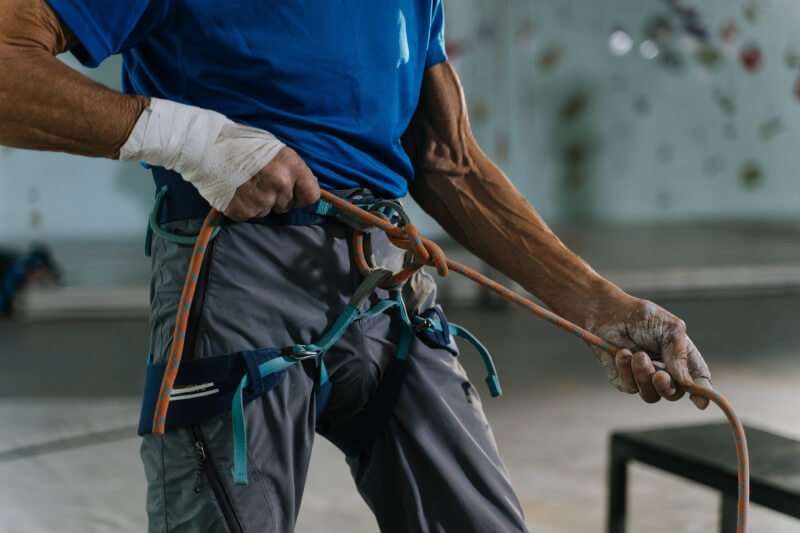Are you looking to create a DIY home gym battle ropes anchor? Look no further! In this article, we provide you with step-by-step instructions on how to create your own battle ropes anchor right in the comfort of your own home. We understand the importance of having a versatile and affordable workout space, and by following these simple instructions, you will be able to enjoy an effective battle ropes workout without the need for expensive equipment or an expensive gym membership. So, grab your tools and get ready to transform your home into a fitness haven in no time!

Materials needed
To create your own battle ropes anchor for your home gym, you will need a few materials. Here’s a list of what you’ll need:
Battle rope
First and foremost, you’ll need a battle rope. Make sure to choose a battle rope that is of good quality and suited to your fitness level. The length of the battle rope will depend on the available space in your home gym and your personal preference.
Towel
You’ll also need a towel to wrap around the door handle. The towel will help protect the door from any potential damage and provide a secure anchor point.
Duct tape
Duct tape will be used to secure the ends of the battle rope and to secure the towel around the door handle. Make sure to choose a strong and durable duct tape that can withstand the tension and force applied during your workout.
Door anchor
A door anchor is a necessary component to create a stable and secure anchor point for your battle ropes. Make sure to choose a door anchor that is sturdy and can handle the tension and force applied during your workout.
Exercise mat
Finally, you’ll need an exercise mat to protect your flooring. Placing an exercise mat underneath the anchor point will help prevent any damage to your floor and provide cushioning for your workout.
Preparing the battle rope
Before you can set up your DIY battle ropes anchor, you’ll need to prepare the battle rope itself.
Cutting the battle rope to the desired length
The length of your battle rope will depend on the available space in your home gym and your personal preference. Measure and cut the battle rope to the desired length, keeping in mind that you will need some extra length to attach it to the door anchor.
Securing the ends of the battle rope with duct tape
To prevent the battle rope from fraying and unraveling, secure the ends of the rope with duct tape. Simply wrap the duct tape around the ends of the rope a few times, ensuring that it is tightly secured.

Creating the anchor point
Now that you have prepared the battle rope, it’s time to create the anchor point for your DIY battle ropes anchor.
Choosing a sturdy door
Select a sturdy door in your home that can handle the tension and force applied during your battle rope workouts. Make sure the door is securely mounted and can withstand the pressure without causing any damage.
Wrapping a towel around the door handle
To protect the door handle and provide a secure anchor point, wrap a towel around the door handle. The towel will help distribute the tension and prevent any damage to the door.
Securing the towel with duct tape
Once the towel is wrapped around the door handle, secure it in place with duct tape. This will ensure that the towel remains in place during your workout and provide a stable anchor point for your battle ropes.
Attaching the battle rope to the anchor
With the anchor point created, it’s time to attach the battle rope to the door anchor.
Connecting the battle rope to the door anchor
Take one end of the battle rope and connect it to the door anchor. Most door anchors have a loop or attachment point where the battle rope can be connected. Follow the manufacturer’s instructions on how to properly attach the battle rope to the door anchor.
Checking the security of the connection
Once the battle rope is attached to the door anchor, give it a gentle tug to ensure that it is securely connected. You don’t want the battle rope to come loose during your workout, so double-check the connection before proceeding.

Protecting the flooring
To protect your flooring from any potential damage and provide added stability to your DIY battle ropes anchor, it’s important to take a few precautions.
Placing an exercise mat underneath the anchor point
Position an exercise mat underneath the anchor point where the battle rope is attached to the door anchor. This will help cushion the impact and prevent any damage to your floor.
Securing the mat in place with duct tape
To ensure that the exercise mat stays in place during your workout, use duct tape to secure it to the floor. This will provide added stability and prevent any unwanted movement of the mat.
Testing the DIY battle ropes anchor
Before you embark on a full-blown battle rope workout, it’s important to test your DIY anchor for any signs of instability or weakness.
Performing basic battle rope exercises
Start by performing a few basic battle rope exercises to test the stability of your DIY anchor. Begin with lighter movements and gradually increase the force and intensity as you feel confident in the anchor’s stability.
Checking for any signs of instability or weakness
While performing the exercises, pay close attention to any signs of instability or weakness in the anchor. Look for movement or shifting of the door anchor, as well as any damage or fraying of the battle rope. If you notice any issues, stop the workout and make the necessary adjustments or repairs.

Maintaining the anchor
To ensure the longevity and safety of your DIY battle ropes anchor, it’s important to regularly inspect and maintain the anchor and its components.
Regularly inspecting the door anchor and battle rope for any damage
On a regular basis, inspect the door anchor and battle rope for any signs of damage or wear. Look for fraying or tearing of the battle rope, as well as any issues with the door anchor’s attachment point. Address any issues promptly to prevent further damage or potential injury.
Replacing any damaged or worn-out parts
If you discover any damaged or worn-out parts during your inspection, it’s important to replace them immediately. A compromised door anchor or battle rope can lead to instability and potential accidents during your workouts. Invest in quality replacement parts to ensure the safety and effectiveness of your DIY battle ropes anchor.
Safety precautions
While using your DIY battle ropes anchor, it’s essential to follow some safety precautions to minimize the risk of injury.
Using the DIY battle ropes anchor in a clear and open space
Ensure that you have enough space around the anchor point to perform battle rope exercises safely. Clear any obstacles and create a clear and open area where you can move freely without the risk of hitting objects or furniture.
Avoiding excessive force or strain on the anchor
Although battle rope exercises can be intense, it’s important not to apply excessive force or strain on the anchor. Always listen to your body and avoid overexerting yourself. Applying too much force could lead to instability or damage to the anchor or door.
Wearing proper workout attire and shoes
When using the DIY battle ropes anchor, make sure to wear proper workout attire and supportive shoes. This will provide you with the comfort and stability you need during your workouts, reducing the risk of slips or falls.

Alternatives to a door anchor
If you are unable to use a door as an anchor point, there are alternative options available.
Using a sturdy tree or post as an anchor
If you have access to a sturdy tree or post outside, you can use it as an anchor point for your battle ropes. Wrap the battle rope around the tree trunk or post, ensuring it is secure and won’t slip during your workout.
Creating a freestanding anchor with PVC pipes
Another option is to create a freestanding anchor using PVC pipes. By building a sturdy frame with PVC pipes, you can have a stable anchor point for your battle ropes without the need for a door or external structure. There are numerous online tutorials and resources available to guide you through the process of building a freestanding anchor with PVC pipes.
Conclusion
With these step-by-step instructions, you can create a DIY battle ropes anchor for your home gym. By using readily available materials and following safety precautions, you can enjoy the benefits of a homemade anchor without the need for expensive equipment. Remember to regularly inspect and maintain your anchor to ensure its longevity and safety, and adjust the setup to suit your individual home gym setup. Get ready to take your battle rope workouts to the next level and achieve your fitness goals in the comfort of your own home.


